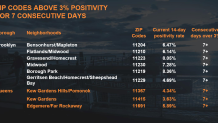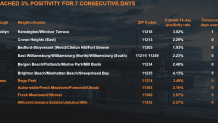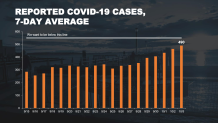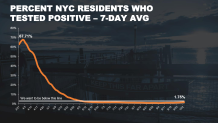What to Know
- Public and private schools will close Tuesday in nine hotspot ZIP codes in Brooklyn and Queens, Gov. Andrew Cuomo said; he also put religious institutions on notice -- follow the rules or face shutdown
- While Cuomo said indoor dining and nonessential business could stay open in the hotspots for now, Mayor de Blasio said he'd move forward with his proposed shutdowns of those unless told otherwise
- 12 other ZIP codes in the same two boroughs are on the brink of the same fate; they've seen heightened case growth but have not yet hit the key threshold of 7 straight days with a 3%-plus positivity rate
About 300 public and private schools in nine New York City hotspot ZIP codes, all in Brooklyn and Queens, will switch to all-remote learning Tuesday, Gov. Andrew Cuomo announced Monday, taking a more immediate approach to curb the city's biggest virus problem in months than the one its mayor had proposed a day earlier.
While the governor did not move to reimpose restrictions on nonessential businesses and indoor dining as Mayor Bill de Blasio had proposed, the mayor said Monday, after Cuomo's briefing, that the city would move ahead with that as planned Wednesday morning unless the state says otherwise. It's not clear if he also planned to still suspend indoor dining in 12 watchlist ZIP codes, also in Brooklyn and Queens, that have yet to hit a certain seven-day positivity threshold.
"Until there is a different plan, we are preparing to implement this plan," de Blasio said when asked about the discrepancy. "The state is reviewing that right now. But we're going to be ready to move as early as Wednesday morning. If the state comes back with a modification, we'll of course follow that modification."
As for the discrepancy between the state and city plans regarding businesses, the mayor said it's part of an "ongoing conversation" between the two entities, and that there is "legitimate concern from both the city and state on how to balance the factors." Cuomo said no decision had been made on whether to close some businesses, and wanted to wait for more information before making a ruling.

Asked why he didn't immediately impose a similar spate of restrictions, Cuomo said schools and large gatherings are top priority given the greater potential for mass spread. In that vein, the governor took a step Monday de Blasio did not propose in his briefing a day earlier and put houses of worship on strict notice. Cuomo threatened state action to close them if community leaders do not agree to abide by and enforce the rules on facial coverings and social distancing.
“If you do not agree to follow the rules, then we will close the institutions down. I am prepared to do that,” Cuomo said.
Right now, the restrictions apply only to hotspot ZIP codes in Southern Brooklyn, Far Rockaway and Central Queens. Cuomo said Rockland and Orange counties could see similar measures at some point if their high infection rates persist, but for now said those counties "don't have the same level of problem" as the city. Cuomo said that closing businesses in the ZIP codes near the clusters would be clumsy and painting with too broad of strokes, and that it could punish areas with still-low COVID rates. While positivity rates have been higher at times, the sample size is much lower.
De Blasio initially proposed his shutdown plan in what has become a rare Sunday briefing, one prompted by soaring positivity rates in certain areas that are threatening to evolve into widespread transmission. Some have spread already.
"These clusters have to be attacked," Cuomo said Monday, referring to clusters in Rockland and Orange counties as well as those in New York City. "Stamp them out immediately and dramatically."
Cuomo, long frustrated with what he perceives to be lacking enforcement by local governments that produced the clusters in the first place, said Monday that the state would assume responsibility for compliance in the hotspot areas. He also went a step further than the mayor and said religious institutions would also be closed if the leaders didn't agree to follow the rules.
The governor's frustration regarding compliance with mask and other health measures was seen as somewhat questionable on Monday, as he was the one not wearing a mask during his press conference in the smaller, confined space of his Manhattan office.
Cuomo's aides asked journalists to try and stay 6 feet apart, but some challenged him during the news conference about his decision not to don a mask in the enclosed space. Cuomo responded that it was fine because he was more than 6 feet away.
“We have sat in these seats six feet apart socially distanced without masks since COVID started,” Cuomo said. “The rule is six feet apart. And that’s what we do.”
A reporter asked Cuomo about evidence that COVID-19 can spread through aerosol transmission.
“If there’s new data than we should come up with a new law,” Cuomo said.
Meanwhile, de Blasio insisted that enforcement was not the primary issue. He also said that the goal in closing stores — and schools — is to avoid a second wave, and that the rollback could last a few weeks.
"The minimum is two weeks dropping below three percent," he said.
As many as 500,000 people live in the Brooklyn and Queens ZIP codes affected by the shutdown, de Blasio said. Roughly 100 public schools and 200 private schools will be subject to closures, a timetable for which remains uncertain at this point. The mayor initially proposed either a two-week shutdown or a four-week shutdown, though Cuomo said the criteria for reopening is still being determined.
De Blasio added a 12th ZIP code Monday -- Forest Hills (11375) to the city's watchlist; that includes areas that have seen COVID cases rise in recent weeks but have yet to hit a seven-day stretch with positivity rates above 3 percent. If they do, they could warrant the same reopening rollbacks.
As of Monday's data, Brighton Beach/Manhattan Beach/Sheepshead Bay (ZIP code 11235) and Rego Park (11374), had seen five straight days with positivity rates above 3 percent. While some of the other neighborhoods on the watchlist have yet to notch one day of positivity rates that high since they've been on the city's radar, de Blasio had proposed indoor dining be immediately suspended in all 12 of the watchlist ZIP codes, which cover bustling neighborhoods like Fort Greene, Clinton Hill and Crown Heights, as well as gyms and indoor pools.

The initial slate of rollbacks approved by Cuomo Monday -- and the persistence of de Blasio's plans to execute the others he did not approve -- signal a disturbing turnaround as New York City, the former epicenter of the U.S. COVID crisis, marked summer's end with less virus spread than most of the rest of the nation.
De Blasio said he was calling for the new restrictions now before the clusters could worsen further, a trend a city that lost tens of thousands of people in a matter of months earlier this year can least afford to continue -- to any degree.
"It's time, I believe fundamentally, having really looked at the data carefully and worked with our public health officials, it's time for to us rewind, to take some of the steps we took before that worked," de Blasio said Monday on CNN. "This is to make sure that this virus does not spread more deeply in those communities, and threaten lives and that it does not spread to the rest of the city. It's a measure I think we have to take to contain the situation before it gets any worse."
Daily Percentage of Positive Tests by New York Region
Gov. Andrew Cuomo breaks the state into 10 regions for testing purposes and tracks positivity rates to identify potential hotspots. Here's the latest tracking data by region and for the five boroughs. For the latest county-level results statewide, click here
Source: ny.gov
Over the past two weeks, the number of new COVID cases has been rising substantially in Brooklyn and Queens. The nine hotspot ZIP codes have accounted for more than 20 percent of cases citywide over the last month, despite representing just 7 percent of the citywide population.
The clusters are slowly beginning to affect New York City's rolling seven-day positivity average, which has ticked up to 1.75 percent in the five boroughs. While comparatively low given the 79 percent positivity rates it was seeing at the peak of the crisis, the city is now seeing higher daily COVID case averages than it has in months. It hit 464 Sunday, then 490 Monday, despite hovering around 250 last month. Hospitalizations are starting to tick up as well, with the city's Health Department saying there has been a slight increase throughout the five boroughs in visits to emergency departments for COVID-like illnesses over the past week. More deaths may follow.
Also of note, the citywide positivity rate for Monday was 1.83 percent, which is inching closer to the two percent threshold that was set in order to keep indoor dining on the table. If the city gets (and stays) above that mark, indoor dining will be shelved once again.


New York City only just lifted its last major restriction -- the one on indoor dining -- last week, allowing eat-in to resume at 25 percent capacity, by state guidelines. The last two waves of public school students also only returned to classes for the first time last week. Some likely now won't get in-person learning at all this month.
Both Cuomo and de Blasio have denied the recent upticks are part of a potential second wave in New York City or the state, but the governor says fall marks a key challenge on the COVID front. Fall means chillier weather, which means fewer outdoor alternatives to certain activities. It means flu season. It means school.
While the state has maintained an extremely low infection rate -- 1 percent excluding the hotspot ZIP codes, slightly higher including them -- Cuomo doesn't believe New York will be able to sustain that through fall, clusters or not.
Tracking Coronavirus in Tri-State
That makes attacking them forcefully and immediately that much more important, he says. Statewide, 20 ZIP codes, all in Brooklyn, Queens and Rockland and Orange counties, are accounting for at least a fifth of New York's daily positive tests on a consistent basis. The positivity rate for the 20 ZIP codes as of Monday was 5.5 percent, while the statewide positivity rate without them is 1.01 percent.
The upticks have particularly alarmed school and union leaders, who fought twice to have in-person learning delayed as they settled on what they believed to be appropriate COVID safety requirements and protocols to ensure a safe return. On Sunday, United Federation of Teachers President Michael Mulgrew praised de Blasio's decision to shut down public schools in the hotspot areas, even though the mayor said the public school connection to the clusters was limited, at worst.
“This is the right decision, one that helps protect our schools, our neighborhoods, and ultimately our city," Mulgrew said Sunday.
He was part of a conversation with Cuomo, de Blasio and other city leaders Monday, the governor said. At his briefing later in the day, he called for more extensive data from the schools in the hotspot clusters, saying the information to date has been insufficient. Cuomo also said the state and city need to refine their approach to not just target ZIP codes, calling it imperfect.
Officials at private Catholic schools in the impacted ZIP codes asked the governor to allow their facilities to keep operating with in-person learning, saying their safety precautions had been working.
Cuomo’s decision “clearly fails to take into account the positive progress our Diocesan school system has made so far this school year,” said Dr. Tom Chadzutko, superintendent of the four schools. “It is unconscionable to think that after the many sacrifices our staff, students, and parents have made, and in spite of our almost non-existent infection rate, the governor has decided to force our four schools to close.”
It is somewhat unsurprising given the recent spike, but the city's Department of Education said on Monday that the number of students who have opted for all-remote learning has has hit 50 percent, continuing an upward trend that has been going on since late August.
COVID-19 at New York City Public Schools
This map shows all known cases of COVID-19 at New York City public schools. It is updated Sunday through Friday at 5:30 PM.
Building that has been closed
One or more classrooms has been closed
A member of the school community has tested positive but the school community was not exposed
Source: nyc.gov
New Jersey has experienced its own upticks as of late, mainly in Ocean County, where Gov. Phil Murphy has said the daily positivity and case totals far outpace the statewide average.
Asked Monday on CNBC whether he would re-impose restrictions, Murphy hinted any potential moves may be similar to the ones being weighed in New York City.
"If we still see the numbers like we have seen over the past number of days, as opposed to a blanket set of decisions or moves, I think you can expect to see something more along the lines of a scalpel, a particular community, a particular step, a particular type of gathering," Murphy said.
The state also said Monday that it is looking into whether the governor's executive order was violated at Trump National in Bedminster, where the president attended a fundraiser last Thursday. State Attorney General Gurbir Grewal was investigating a number of possible violations, including if the gathering featured too many people and a report that guests were served food buffet-style, which is not allowed.
The investigation, and scramble to reach more than 200 guests and 19 staff for contact tracing, were called for after the White House said it knew Trump had been exposed to the coronavirus before he left for Bedminster, but went ahead with the trip anyway. Contact tracers from the Somerset County Health Department said they had reached most of the guests and staff, but not all.
"This is a race against the clock," Murphy said.
The local developments come as the nation confronts the crisis anew following the positive diagnosis of President Donald Trump, First Lady Melania Trump and a growing number of members of his inner circle — including former New Jersey Gov. Chris Christie, who was part of the president's debate prep team last weekend, almost all of whom have since tested positive for COVID.
According to a columnist for the New Jersey Star Ledger, who spoke to the former GOP governor for 10 minutes Monday, Christie sounded raspy, but didn’t want to talk about details about his health or his treatment, the article said.
The president left the hospital Monday evening to return to the White House, where his doctors said he will continue his treatment and his recovery. He wore a mask while leaving the hospital and after exiting the helicopter on the White House lawn, but took it off soon after while around White House staffers.
Trump later posted a video on Twitter in which he told Americans about COVID, "don't let it dominate you, don't be afraid of it, we're going to beat it." The United States has lost more people to the virus and confirmed more cases than any country in the world, with well more than 200,000 dead and nearly 8 million COVID cases diagnosed.
Meanwhile, the true picture of the breadth of infection continues to take shape globally. The World Health Organization said Monday that it estimates up to 10 percent of the global population may have been infected at some point which is more than 20 times the confirmed number of cases worldwide.



